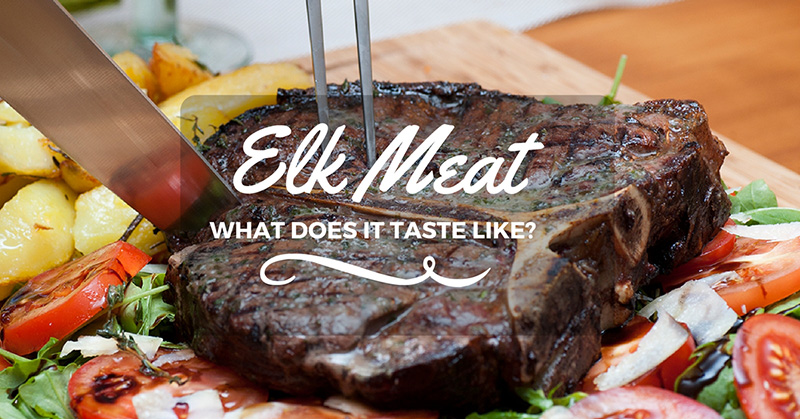Elk. The very name conjures images of pristine mountain ranges, vast forests, and a creature emblematic of the untamed wilderness. But beyond the visual spectacle, lies a culinary enigma: What, precisely, does elk taste like? The answer, unsurprisingly, is multifaceted, a tapestry woven from factors ranging from the animal’s diet to the meticulousness of the preparation.
Let’s embark on a gustatory expedition to unpack the nuanced flavors of this majestic animal. Understanding the taste of elk involves dissecting its composition, contrasting it with familiar meats, and exploring the ideal cooking methods to unlock its potential.
A Symphony of Flavors: Decoding the Elk’s Profile
Elk, at its core, presents a flavor profile that is often described as a midpoint between beef and venison. It possesses a certain gaminess, a whisper of the wild, that distinguishes it from domesticated cattle. This isn’t the assertive, sometimes overpowering gaminess that can characterize older or improperly handled venison. Instead, it’s a more subtle earthiness, a hint of forest floor and wild herbs, imparted by the elk’s natural diet.
Consider the marbling, that network of intramuscular fat that contributes so significantly to the succulence and flavor of beef. Elk tends to be leaner than beef, resulting in a less pronounced fatty richness. This leanness translates into a cleaner, purer flavor, one that is not masked by excessive fat. The fat that is present tends to be more subtly flavored, contributing a delicate herbaceousness rather than a pronounced tallowy note.
The texture of elk is another crucial element of its appeal. Well-prepared elk should be tender and yielding, possessing a fine grain that melts in the mouth. Overcooking, however, can transform this delicate texture into something tough and chewy. Achieving that perfect balance is paramount to unlocking the elk’s full potential.
Elk vs. Beef and Venison: A Comparative Gastronomy
To truly appreciate the taste of elk, it’s helpful to draw comparisons to other familiar meats. Compared to beef, elk offers a leaner, more delicately flavored experience. The robust, almost iron-rich flavor of beef is replaced by a lighter, more nuanced profile in elk. Think of it as the difference between a bold Cabernet Sauvignon and a refined Pinot Noir.
The comparison to venison is perhaps even more illuminating. While both elk and deer are members of the Cervidae family, their flavors diverge in subtle yet significant ways. Venison can often exhibit a stronger, more pronounced gaminess, particularly if it’s not handled with care. Elk, on the other hand, tends to be milder and more approachable, making it a palatable option even for those who typically shy away from game meats.
Imagine venison as a rustic, earthy loaf of whole-grain bread, and elk as a more refined, delicately flavored sourdough. Both are delicious in their own right, but they offer distinct sensory experiences.
Unlocking the Elk’s Potential: Cooking Methods and Culinary Alchemy
The key to preparing elk lies in understanding its leanness. Due to its lower fat content, elk is prone to drying out if overcooked. Therefore, techniques that preserve moisture are particularly well-suited to this meat. Consider slow-cooking methods like braising or stewing, which allow the elk to become meltingly tender while infusing it with rich flavors.
Marinating elk before cooking can also help to tenderize the meat and add moisture. Acidic marinades, such as those containing citrus juice or vinegar, can break down the muscle fibers and enhance the overall flavor profile. A simple marinade of olive oil, garlic, herbs, and lemon juice can work wonders.
For quicker cooking methods like grilling or pan-searing, it’s crucial to avoid overcooking. Aim for a medium-rare to medium doneness, which will ensure that the elk remains tender and juicy. Searing the meat over high heat to create a flavorful crust is also a great way to enhance its appeal.
Pairing elk with complementary flavors can elevate the dining experience even further. Earthy ingredients like mushrooms, root vegetables, and herbs such as rosemary and thyme work exceptionally well. Fruity sauces, such as those made with cranberries or cherries, can also provide a delightful counterpoint to the elk’s savory flavor.
Think of cooking elk as a culinary dance, a delicate balance between technique and intuition. Understanding the nuances of the meat and employing the right methods will unlock a truly exceptional dining experience.
A Culinary Treasure: The Enduring Allure of Elk
Ultimately, the taste of elk is a subjective experience, shaped by individual palates and culinary preferences. However, its inherent qualities – its lean texture, subtle gaminess, and delicate flavor – make it a truly unique and rewarding meat to explore.
Elk offers a taste of the wild, a connection to the natural world, and a culinary adventure that is both sophisticated and satisfying. From the seasoned gourmand to the adventurous home cook, elk presents a challenge and an opportunity to discover a flavor that is both distinctive and deeply appealing. So, venture forth and savor the taste of the majestic elk – a culinary treasure waiting to be unearthed.









Leave a Comment